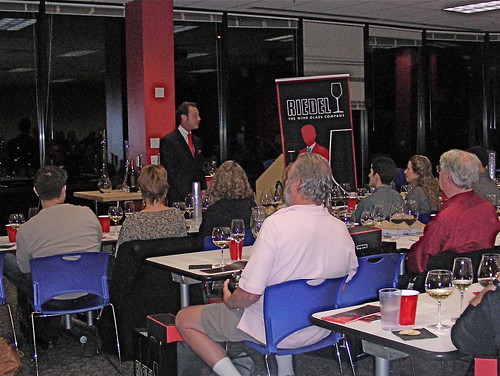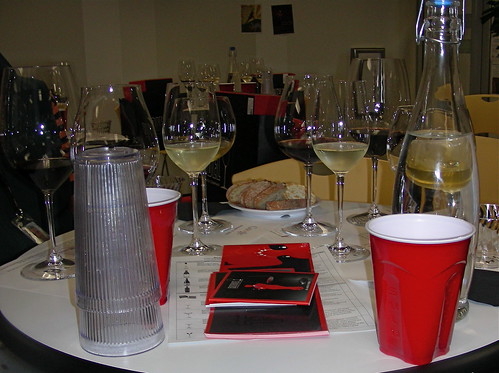Maximilian Riedel is currently the CEO of the US branch of Riedel Glas, the Austrian glassmaker company that introduced the concept of varietal specific wine glasses. He also regularly hosts tasting events to demonstrate how the shape of the glass can influence the way we perceive wine. According to Riedel, a wine can display different characteristics — good or bad — when served in glasses of different sizes and shapes.

Riedel wine glass tasting with Maximilian Riedel
In order to illustrate that concept, four wines were paired with four varietal glasses from the Riedel Vinum XL series, one of Riedel's most recent lines specifically designed for young new world wines.

Riedel tasting setup
We started with a 2009 Giesen Sauvignon Blanc Marlborough that we tasted in a Vinum XL Riesling Grand Cru glass. The wine had a light yellow color with green reflections and a fresh and fruity nose of grapefruit and gooseberry. On the palate, it was crisp and mineral with a good finish. After having enjoyed the wine in the Riesling glass, we were asked to pour some of it into a small plastic cup. The difference was remarkable. In the plastic cup, the wine had no nose at all and tasted mostly acidic. It is actually easy to understand why: in a small V-shaped cup, there is no room to swirl the wine and bring out the aromas. Moreover, the V-shape is the wrong shape to concentrate the aromas towards the nose (much of what we taste really comes through our nose).
Then we moved to our second wine, a 2008 Talbott Chardonnay Sleepy Hollow Vineyard that we tasted in a Vinum XL Montrachet glass. The wine was deep golden with a nose of apple, pear, and nut. On the palate, it was rich and creamy with notes of caramel. The glass bowl was large and round, which helped temper the alcohol in the wine. It also directed the flow of wine to cover a large area in the mouth, thus enhancing the richness and acidy of the wine. Then we tried the Chardonnay in the Riesling glass. The wine seemed more unbalanced, drier, and not as crisp. The reason is that the Riesling glass, designed for unoaked acidic wines like dry Riesling and Sauvignon Blanc, is much too narrow to allow the creamy aromas to expand towards the nose and in the mouth.
Our third wine was a 2008 Kali-Hart Vineyard Pinot Noir that we tasted in a Vinum XL Pinot Noir glass, a glass with a large tulip-shaped bowl that flares out slightly at the top. The wine had a deep ruby color and a nose of raspberry, dried fruits and raisins. On the palate, it was full-bodied and jammy. When we were asked to try the wine in the Chardonnay glass, we noticed that the wine seemed less fruity and more tannic. In fact, the wine flow reaching the tongue was less focused and much less of these fruity aromas were reaching our tongue.
Our last wine was the 2007 Educated Guess Cabernet Sauvignon Napa Valley that we tasted in the oversized Vinum Xl Cabernet glass. The wine was dark with a nose of sweet blackberry, cocoa, and vanilla. On the palate, it was full-bodied, young, and oaky. When we switched to the Pinot Noir glass, the wine appeared more tannic, maybe because of the flared top, and in the Chardonnay glass, the opening was too wide and the wine aromas were partly lost.
At the end of the event, we each received a Vinum Xl wine tasting glass set so that we can continue to play at home. There are so many combinations that we haven't tried yet. What about a Sauvignon Blanc in the Chardonnay glass or a Pinot Noir in the Cabernet glass? I'm also suspecting that the Vinum Xl Cabernet glass might be too big for a Bordeaux.
Technorati tags: wine food & drink
3 comments:
Good products information sharing in to the post.
-----
riedel glasses
If you are going to have a set of glasses for best, they may as well help you to get full value out of the for-best wines they’ll mostly contain.
Great site very informative article thank you…cheers Peter
Post a Comment